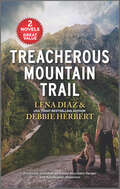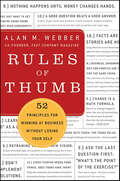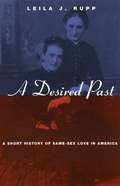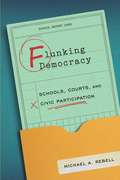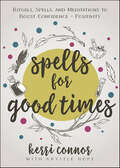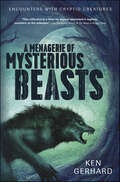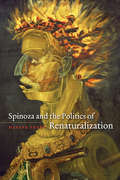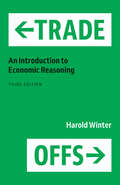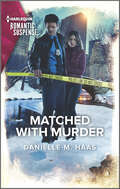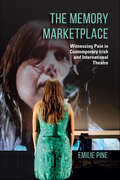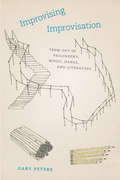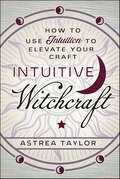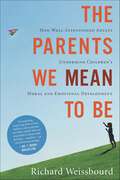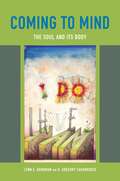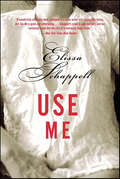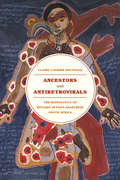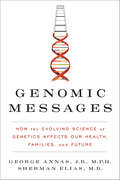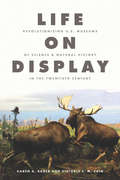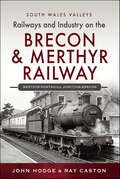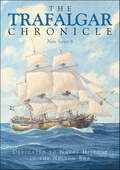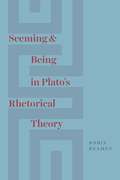- Table View
- List View
Treacherous Mountain Trail
by Lena Diaz Debbie HerbertThe heights of dangerSmoky Mountains Ranger by Lena Diaz Adam McKenzie&’s protective instincts are on overdrive, but Jody Ingram is no helpless victim. She refuses to abandon the injured ranger who saved her life despite the mysterious gunmen hot on her trail. When their forced flight through treacherous mountain terrain leads to unbridled passion, Adam must decide if guarding Jody 24/7 is worth the risk to his life and his heart…Appalachian Abduction by Debbie Herbert Trespassing, fleeing a peace officer…hell, she&’d aimed a gun at his chest! Officer James Tedder can&’t help but admire her fight. And undercover detective Charlotte Helms will never quit. She&’s on a personal mission: rescue her best friend&’s daughter…and bust the child-trafficking ring that lured her away. When they&’re forced to become partners, James must trust Charlotte to have his back. But can he trust her with his heart?USA TODAY Bestselling Author Debbie Herbert Previously published as Smoky Mountains Ranger and Appalachian Abduction
Rules of Thumb: 52 Principles for Winning at Business without Losing Your Self
by Alan M. WebberA Fast Company founder and former editorial director of Harvard Business Review provides “guidance and hope in a world gone upside down” (Jim Collins, New York Times–bestselling author of Good to Great).Take your work seriously, Yourself, not so much.Loyalty is a two-way street.Don’t implement solutions. Prevent problems.This dramatic, unpredictable era has wiped out time-honored businesses and long-standing institutions while ushering in unprecedented opportunities for creative individuals and entrepreneurial organizations. The job is no longer figuring out how to win at the game of work and life—it’s figuring out the new rules of the game.Rules of Thumb provides fifty-two rules for individuals in every walk of life who want to make sense out of these confusing, challenging, and compelling times. If you're looking for practical advice on how to win at work without losing your self, if you want to change your life to meet the challenge of change, or if you want to learn from some of the world’s most interesting and creative people, let entrepreneur, Santa Fe mayor, and acclaimed business author Alan M. Webber take you on a remarkable journey toward greater personal understanding and, ultimately, greater personal success.“Fifty-two practical lessons gleaned from more than forty years of working with extraordinary leaders in a variety of endeavors . . . valuable, thought-provoking ideas.” —Booklist
A Desired Past: A Short History of Same-Sex Love in America
by Leila J. RuppeWith this book, Leila J. Rupp accomplishes what few scholars have even attempted: she combines a vast array of scholarship on supposedly discrete episodes in American history into an entertaining and entirely readable story of same-sex desire across the country and the centuries. "Most extraordinary about Leila J. Rupp's indeed short, two-hundred-page history of 'same-sex love and sexuality' is not that it manages to account for such a variety of individuals, races, and classes or take in such a broad chronological and thematic range, but rather that it does all this with such verve, lucidity, and analytical rigor. . . . [A]n elegant, inspiring survey." —John Howard, Journal of American History
Flunking Democracy: Schools, Courts, and Civic Participation
by Michael A. RebellThe 2016 presidential election campaign and its aftermath have underscored worrisome trends in the present state of our democracy: the extreme polarization of the electorate, the dismissal of people with opposing views, and the widespread acceptance and circulation of one-sided and factually erroneous information. Only a small proportion of those who are eligible actually vote, and a declining number of citizens actively participate in local community activities. In Flunking Democracy, Michael A. Rebell makes the case that this is not a recent problem, but rather that for generations now, America’s schools have systematically failed to prepare students to be capable citizens. Rebell analyzes the causes of this failure, provides a detailed analysis of what we know about how to prepare students for productive citizenship, and considers examples of best practices. Rebell further argues that this civic decline is also a legal failure—a gross violation of both federal and state constitutions that can only be addressed by the courts. Flunking Democracy concludes with specific recommendations for how the courts can and should address this deficiency, and is essential reading for anyone interested in education, the law, and democratic society.
Spells for Good Times: Rituals, Spells, and Meditations to Boost Confidence + Positivity
by Kerri Connor Krystle HopeSay Hello to a Brighter, Happier FutureFeaturing a variety of simple spells, rituals, meditations, and more, this practical guide helps you and your community raise positive energy and create the loving, compassionate world you desire. Bring out the best in yourself and others with more than fifty activities, such as a spell to cope with loss and a ritual to heal a community divide. This book also covers how to nourish your body, mind, and spirit with wholesome self-care recipes, like revitalizing shower steamers and lavender rose hot chocolate. Filled with tools that can be used throughout the day, this cheerful book shows you that now is the perfect time to step into the sunny, joy-filled life you deserve.
A Menagerie of Mysterious Beasts: Encounters with Cryptid Creatures
by Ken GerhardDraw Back the Curtain and Marvel at the Amazing Collection of Mysterious Beasts WithinJoin cryptozoologist Ken Gerhard on an enigmatic journey through the world of mysterious beasts, exploring eyewitness encounters with creatures thought to exist only in myths and legends. This compelling compendium presents a wide variety of astounding and bizarre creatures, from the Minnesota Iceman to the White Bluff Screamer to the Texas T. rex.Discover the fascinating history and modern case studies of ape-men roaming the Americas. Experience captivating, first-hand accounts of dragon, werewolf, and mermaid sightings from Europe to Australia. Featuring sea monsters, colossal insects, enormous eagles, oversized amphibians, and more, A Menagerie of Mysterious Beasts is the ultimate resource for cryptid creature enthusiasts.Praise:"In his new book, Ken Gerhard—the Indiana Jones of monster-hunting—provides us with an absolute smorgasbord of unknown animals."—Nick Redfern, author of Chupacabra Road Trip"Ken Gerhard's writings are always replete with original research and hitherto-unpublished reports. A Menagerie of Mysterious Beasts is no exception—a monstrously good, thoroughly entertaining, and highly informative read for cryptozoology fans everywhere!"—Dr. Karl P.N. Shuker, author of A Manifestation of Monsters"Ken Gerhard deftly blends authentic historical accounts with piles of new eyewitness reports to create a heady, global cocktail of cryptid mysteries."—Linda S. Godfrey, author of American Monsters"After reading this menagerie of the damned you will be in no doubt that monsters are real."—Richard Freeman, author of Dragons"Ken brings us an excellent read, a combination of his own personal investigations and direct eyewitness testimony. Importantly, the book flows very well as it deals with a variety of cryptids, including more controversial subjects which he is to be credited for not shying away from."—Adam Davies, cryptozoologist and explorer
Spinoza and the Politics of Renaturalization
by Hasana SharpThere have been many Spinozas over the centuries: atheist, romantic pantheist, great thinker of the multitude, advocate of the liberated individual, and rigorous rationalist. The common thread connecting all of these clashing perspectives is Spinoza’s naturalism, the idea that humanity is part of nature, not above it. In this sophisticated new interpretation of Spinoza’s iconoclastic philosophy, Hasana Sharp draws on his uncompromising naturalism to rethink human agency, ethics, and political practice. Sharp uses Spinoza to outline a practical wisdom of “renaturalization,” showing how ideas, actions, and institutions are never merely products of human intention or design, but outcomes of the complex relationships among natural forces beyond our control. This lack of a metaphysical or moral division between humanity and the rest of nature, Sharp contends, can provide the basis for an ethical and political practice free from the tendency to view ourselves as either gods or beasts. Sharp’s groundbreaking argument critically engages with important contemporary thinkers—including deep ecologists, feminists, and race and critical theorists—making Spinoza and the Politics of Renaturalization vital for a wide range of scholars.
Trade-Offs: An Introduction to Economic Reasoning
by Harold WinterThe highly engaging introduction to thinking like an economist, updated for a new generation of readers.When economists wrestle with any social issue—be it unemployment, inflation, healthcare, or crime and punishment—they do so impersonally. The big question for them is: what are the costs and benefits, or trade-offs, of the solutions to such matters? These trade-offs constitute the core of how economists see the world—and make the policies that govern it.Trade-Offs is an introduction to the economic approach of analyzing controversial policy issues. A useful introduction to the various factors that inform public opinion and policymaking, Trade-Offs is composed of case studies on topics drawn from across contemporary law and society.Intellectually stimulating yet accessible and entertaining, Trade-Offs will be appreciated by students of economics, public policy, health administration, political science, and law, as well as by anyone following current social policy debates.
Matched with Murder
by Danielle M. HaasCan revealing her secrets stop a murderer…Before she becomes the next victim? When Samantha Gates resists cooperating with a murder investigation, she gets under Detective Max Green's skin. Though the killer's victims all used her dating site, the high-profile CEO is obviously hiding something. Then he targets Samantha herself. Suddenly the stakes are even higher…and complicated by a very deep—and potentially lethal—attraction.From Harlequin Romantic Suspense: Danger. Passion. Drama.Feel the excitement in these uplifting romances, part of the series:
The Memory Marketplace: Witnessing Pain in Contemporary Irish and International Theatre (Irish Culture, Memory, Place)
by Emilie PineWhat happens when cultural memory becomes a commodity? Who owns the memory? In The Memory Marketplace, Emilie Pine explores how memory is performed both in Ireland and abroad by considering the significant body of contemporary Irish theatre that contends with its own culture and history. Analyzing examples from this realm of theatre, Pine focuses on the idea of witnesses, both as performers on stage and as members of the audience. Whose memories are observed in these transactions, and how and why do performances prioritize some memories over others? What does it mean to create, rehearse, perform, and purchase the theatricalization of memory? The Memory Marketplace shows this transaction to be particularly fraught in the theatricalization of traumatic moments of cultural upheaval, such as the child sexual abuse scandal in Ireland. In these performances, the role of empathy becomes key within the marketplace dynamic, and Pine argues that this empathy shapes the kinds of witnesses created. The complexities and nuances of this exchange—subject and witness, spectator and performer, consumer and commodified—provide a deeper understanding of the crucial role theatre plays in shaping public understanding of trauma, memory, and history.
Improvising Improvisation: From Out of Philosophy, Music, Dance, and Literature
by Gary PetersThere is an ever-increasing number of books on improvisation, ones that richly recount experiences in the heat of the creative moment, theorize on the essence of improvisation, and offer convincing arguments for improvisation’s impact across a wide range of human activity. This book is nothing like that. In a provocative and at times moving experiment, Gary Peters takes a different approach, turning the philosophy of improvisation upside-down and inside-out. Guided by Kant, Hegel, Heidegger, and especially Deleuze—and exploring a range of artists from Hendrix to Borges—Peters illuminates new fundamentals about what, as an experience, improvisation truly is. As he shows, improvisation isn’t so much a genre, idiom, style, or technique—it’s a predicament we are thrown into, one we find ourselves in. The predicament, he shows, is a complex entwinement of choice and decision. The performativity of choice during improvisation may happen “in the moment,” but it is already determined by an a priori mode of decision. In this way, improvisation happens both within and around the actual moment, negotiating a simultaneous past, present, and future. Examining these and other often ignored dimensions of spontaneous creativity, Peters proposes a consistently challenging and rigorously argued new perspective on improvisation across an extraordinary range of disciplines.
Intuitive Witchcraft: How to Use Intuition to Elevate Your Craft
by Astrea Taylor“An absolutely terrific book, full of heart, practical advice, and some of the best witchcraft to make the printed page in years.” ―Jason Mankey, author of The Horned God of the WitchesFeaturing extensive exercises, examples, and rituals, this amazing book reveals how to embrace the wisdom of your inner voice as you explore the endless possibilities of witchcraft. With Astrea Taylor’s guidance, you can unlock your intuitive magical potential and celebrate the truth of who you are.Intuitive Witchcraft also offers insights from some of the best writers, thinkers, and leaders in their fields, helping you become your most empowered self. Discover how to work with energy, interact with deities and spirits, and create a personal practice that fits your beliefs and lifestyles. Learn to face your shadow side, make the mundane magical, use divination tools, and much more. Whether you’re a beginner or advanced practitioner, this incredible book illuminates the path to manifesting your greatest desires in an intuitive way.“Provides techniques for melding intuition and witchcraft in a way that is emotionally and spiritually satisfying.” ―Publishers Weekly“The exercises are a great way to enhance your intuitive connection to nature, deity, and magical practice . . . This book has something useful for practitioners at every level.” ―Alfred Willowhawk, author of I Am Healer, Storyteller and WarriorPriest and host of the podcast Up Close & Personal“From personal shadow work to rituals, to forming your own practicing groups, Astrea brings intuition to the forefront of Witchcraft.” ―Phoenix LeFae, author of Life Ritualized
The Parents We Mean to Be: How Well-Intentioned Adults Undermine Children's Moral and Emotional Development
by Richard WeissbourdA wake-up call for a national crisis in parenting—and a deeply helpful book for those who want to see their own behaviors as parents with the greatest possible clarity.Harvard psychologist Richard Weissbourd argues incisively that parents—not peers, not television—are the primary shapers of their children’s moral lives. And yet, it is parents’ lack of self-awareness and confused priorities that are dangerously undermining children’s development.Through the author’s own original field research, including hundreds of rich, revealing conversations with children, parents, teachers, and coaches, a surprising picture emerges. Parents’ intense focus on their children’s happiness is turning many children into self-involved, fragile conformists.The suddenly widespread desire of parents to be closer to their children—a heartening trend in many ways—often undercuts kids’ morality. Our fixation with being great parents—and our need for our children to reflect that greatness—can actually make them feel ashamed for failing to measure up. Finally, parents’ interactions with coaches and teachers—and coaches’ and teachers’ interactions with children—are critical arenas for nurturing, or eroding, children’s moral lives.Weissbourd’s ultimately compassionate message—based on compelling new research—is that the intense, crisis-filled, and profoundly joyous process of raising a child can be a powerful force for our own moral development.
Coming to Mind: The Soul and Its Body
by Lenn E. Goodman D. Gregory CaramencioHow should we speak of bodies and souls? In Coming to Mind, Lenn E. Goodman and D. Gregory Caramenico pick their way through the minefields of materialist reductionism to present the soul not as the brain’s rival but as its partner. What acts, they argue, is what is real. The soul is not an ethereal wisp but a lively subject, emergent from the body but inadequately described in its terms. Rooted in some of the richest philosophical and intellectual traditions of Western and Eastern philosophy, psychology, literature, and the arts and the latest findings of cognitive psychology and brain science—Coming to Mind is a subtle manifesto of a new humanism and an outstanding contribution to our understanding of the human person. Drawing on new and classical understandings of perception, consciousness, memory, agency, and creativity, Goodman and Caramenico frame a convincing argument for a dynamic and integrated self capable of language, thought, discovery, caring, and love.
Use Me
by Elissa SchappellThe exquisitely artful fiction debut of Vanity Fair columnist Elissa Schappell is a novel told in ten stories that resonate with the most profound experiences in the life of a young woman -- friendship and rivalry, the love for a man, the birth of a child, and the death of a father.
The Cholera Years: The United States in 1832, 1849, and 1866
by Charles E. RosenbergA history of the nineteenth-century epidemic and a &“skillful, absorbing presentation of the background and the effects of this dread disease&” (The New York Times). Cholera was the classic epidemic disease of the nineteenth century, as the plague had been for the fourteenth. Its defeat was a reflection not only of progress in medical knowledge but of enduring changes in American social thought. In this book Charles Rosenberg has focused his study on New York City, the most highly developed center of this new society. Carefully documented, full of descriptive detail, yet written with an urgent sense of the drama of the epidemic years, this narrative is as absorbing for general audiences as it is for the medical historian. In a new afterword, Rosenberg also discusses changes in historical method and concerns since the original publication of The Cholera Years. &“A major work of interpretation of medical and social thought.&”—I.B. Cohen, The New York Times &“A masterful analysis.&”—Steven Shapin, Times Literary Supplement &“In a way that is all too rarely done, Rosenberg has skillfully interwoven medical, social, and intellectual history to show how medicine and society interacted and changed during the 19th century. The history of medicine here takes its rightful place in the tapestry of human history.&”—John B. Blake, Science
Ancestors and Antiretrovirals: The Biopolitics of HIV/AIDS in Post-Apartheid South Africa
by Claire Laurier DecoteauIn the years since the end of apartheid, South Africans have enjoyed a progressive constitution, considerable access to social services for the poor and sick, and a booming economy that has made their nation into one of the wealthiest on the continent. At the same time, South Africa experiences extremely unequal income distribution, and its citizens suffer the highest prevalence of HIV in the world. As Archbishop Desmond Tutu has noted, “AIDS is South Africa’s new apartheid.” In Ancestors and Antiretrovirals, Claire Laurier Decoteau backs up Tutu’s assertion with powerful arguments about how this came to pass. Decoteau traces the historical shifts in health policy after apartheid and describes their effects, detailing, in particular, the changing relationship between biomedical and indigenous health care, both at the national and the local level. Decoteau tells this story from the perspective of those living with and dying from AIDS in Johannesburg’s squatter camps. At the same time, she exposes the complex and often contradictory ways that the South African government has failed to balance the demands of neoliberal capital with the considerable health needs of its population.
Genomic Messages: How the Evolving Science of Genetics Affects Our Health, Families, and Future
by Sherman Elias George AnnasTwo leaders in the field of genetics—a bioethicist-health lawyer and an obstetrician-gynecologist geneticist—answer the most pressing questions about the application of new genetics to our universal medicine and what personalized medicine means for individual healthcare.Breakthroughs in genetic research are changing modern medicine and pharmaceuticals. But what are these changes and how do they affect our individual care? Genomic Messages examines these groundbreaking changes and the questions they raise: What kind of specific medical innovation do we have to look forward to now and tomorrow? How will this “flood” of genetic messages change our lives, our interaction with our physicians and our healthcare system?Groundbreaking and provocative, Genomic Messages fuses the often conflicting worlds of medicine and law to provide information and insight that will impact the health choices of every one of us, from how medicine is practiced to concepts of privacy, confidentiality, and informed consent. Ultimately, it reveals how genetic information is changing how we think about ourselves, our health, and our future.
Life on Display: Revolutionizing U.S. Museums of Science and Natural History in the Twentieth Century
by Karen A. Rader Victoria E.M. CainRich with archival detail and compelling characters, Life on Display uses the history of biological exhibitions to analyze museums’ shifting roles in twentieth-century American science and society. Karen A. Rader and Victoria E. M. Cain chronicle profound changes in these exhibitions—and the institutions that housed them—between 1910 and 1990, ultimately offering new perspectives on the history of museums, science, and science education. Rader and Cain explain why science and natural history museums began to welcome new audiences between the 1900s and the 1920s and chronicle the turmoil that resulted from the introduction of new kinds of biological displays. They describe how these displays of life changed dramatically once again in the 1930s and 1940s, as museums negotiated changing, often conflicting interests of scientists, educators, and visitors. The authors then reveal how museum staffs, facing intense public and scientific scrutiny, experimented with wildly different definitions of life science and life science education from the 1950s through the 1980s. The book concludes with a discussion of the influence that corporate sponsorship and blockbuster economics wielded over science and natural history museums in the century’s last decades. A vivid, entertaining study of the ways science and natural history museums shaped and were shaped by understandings of science and public education in the twentieth-century United States, Life on Display will appeal to historians, sociologists, and ethnographers of American science and culture, as well as museum practitioners and general readers.
Kidnapped! (Forbidden Fantasies)
by Jo LeighOkay, it's certainly an unconventional way for Manhattanheiress Tate Baxter to conquer her fears. But when yourwhole life takes place behind the tinted windows of a limoand your household staff are all gun-toting ex-CIA, drasticmeasures have to be taken. Especially when one memberof that staff has got her all hot and bothered. Chauffeur Michael Caulfield has just one assignment-keeping Tate safe. But when she's kidnapped for real,the only way he can save her is to become a prisonerwith her. He may be just "the help," but as her take-chargeprotector, he's the Michael of her sexual fantasies.Maybe a man she can trust and even dare to love?Except once out of his uniform, he isn't exactly layingbare all his secrets...to Tate.
Railways and Industry on the Brecon & Merthyr Railway (South Wales Valleys)
by John Hodge R. J. CastonThe third in a trilogy on the Brecon & Merthyr Railway, this book covers the line from Merthyr to Pontsticill where it met the line from Newport and continued to Brecon. Between Pontsticill and Brecon the line ran through beautiful scenery with reservoirs on the west side and the Brecon Beacons on the east with the famous Seven Mile bank to test the ability of fireman not to stall their engine. The book is hugely illustrated as it passes through Pontsticill and on through Dolygaer, Pentir Rhiw, Torpantau and Talybont on Usk, this being one of the most scenic sections of the Western Region. Talyllyn and Brecon itself are also very well illustrated giving an idea also of the variety of services that ran into Brecon, not only from Newport, but from Neath, Hereford and Mid-Wales. Passenger services to Brecon from all these places were withdrawn in December 1962, though freight, mostly domestic coal, services from Merthyr continued until 1964. The area is not without some passenger services however in the present day as the Brecon Mountain Railway has been developed between Pant, Pontsticill and Torpantau. This final volume of three provides views in stark contrast to the industrial section at the south end of the Brecon & Merthyr where it runs through the South Wales Coalfield and the former iron producing areas of Merthyr and Dowlais.
The Trafalgar Chronicle: Dedicated to Naval History in the Nelson Era, New Series 8
by Judy Pearson John RodgaardThe Trafalgar Chronicle is the publication of choice for new, scholarly research about the Georgian Navy, sometimes called ‘Nelson’s Navy’; the journal’s scope, however, includes all the sailing navies of the period 1714 to 1837. This year’s volume includes three articles on highly original topics. First, an analysis of the various swords the Duke of Clarence gave as gifts to Royal Navy officers. Second, is a deeply researched piece into early nineteenth-century court records to document the many incarnations of a Royal Navy schooner, Whiting, which, after capture by a French privateer in the War of 1812, became, herself, a privateer and a pirate ship. The last of three articles in this section gives an analysis of what Nelson thought of privateers, especially after the French xebec L’Esperance took his cutter Swift as a prize. To recognize the 500th anniversary of the founding of the Swedish Navy, there are included three articles from a new compilation The Baltic Cauldron, a collection of papers on the Swedish Navy, from 1522 to the present. It includes a piece by Christer Hägg, former captain in the Royal Swedish Navy and an accomplished maritime artist whose painting graces the cover of this edition. Readers will also find outstanding biographical portraits. First, there is a recounting of Charles Cunningham’s daring decisions and steely resolve when he extricated his ship, HMS Clyde, from the heated Nore Mutiny. Another article describes the parallel and contemporary naval service exploits of Admirals Rodney and Kempenfelt, who were actually distant cousins of one another. The final biographical paper takes readers to Bermuda where a twenty-first century archeological dig found the remains of Captain Sir Jacob Wheate, who commanded the ill-fated Fifth Rate frigate HMS Cerberus. Authors in this volume reside in six countries: UK, US, India, Australia, Canada, and Sweden. Through extensive research, they tell dramatic stories of mutiny, piracy, privateering, battles at sea, diplomacy, international alliances, victory and advancement, loss and defeat, all in the quest for sea power. Handsomely illustrated throughout, this issue will make a fascinating and admired addition to any naval library. "Well written, well researched, well-illustrated, this is a publication that will both delight and inform. A most enjoyable read." - D J Paul in Naval Review
Seeming & Being in Plato’s Rhetorical Theory
by Robin ReamesThe widespread understanding of language in the West is that it represents the world. This view, however, has not always been commonplace. In fact, it is a theory of language conceived by Plato, culminating in The Sophist. In that dialogue Plato introduced the idea of statements as being either true or false, where the distinction between falsity and truth rests on a deeper discrepancy between appearance and reality, or seeming and being. Robin Reames’s Seeming & Being in Plato’s Rhetorical Theory marks a shift in Plato scholarship. Reames argues that an appropriate understanding of rhetorical theory in Plato’s dialogues illuminates how he developed the technical vocabulary needed to construct the very distinctions between seeming and being that separate true from false speech. By engaging with three key movements of twentieth- and twenty-first-century Plato scholarship—the rise and subsequent marginalization of “orality and literacy theory,” Heidegger’s controversial critique of Platonist metaphysics, and the influence of literary or dramatic readings of the dialogues—Reames demonstrates how the development of Plato’s rhetorical theory across several of his dialogues (Gorgias, Phaedrus, Protagoras, Theaetetus, Cratylus, Republic, and Sophist) has been both neglected and misunderstood.
When Less Is More: The Complete Guide for Women Considering Breast Reduction Surgery
by Bethanne SnodgrassIf you have ever thought that your breasts are too big, this book is for you. Do you suffer from chronic back and neck pain? Do you struggle to sit up straight? What about frequent headaches or hand numbness? Disabling muscle and joint pain, discolored shoulder grooves from your bra straps, and rashes under your breasts are just some of the symptoms caused by heavy breasts. Many large-breasted women also suffer psychologically from poor body image and unwanted sexual attention. Sound familiar? If so, When Less Is More will provide you with the information you need to make an informed decision about a procedure that can transform your life.Breast reduction is among the top ten most commonly performed major plastic surgical procedures, as common as facelift surgery. Most women experience dramatic symptom relief and emotional benefits after the procedure. In fact, the vast majority of women who have breast reduction surgery would have it again or recommend it to a friend. Even celebrities are speaking out about their breast reductions and the life-changing benefits they have experienced as a result. However, making the decision to have surgery can be difficult, and most women consider it for years before taking action. Unfortunately, despite the media attention and increasing frequency of the procedure, there is an alarming lack of accurate information regarding the surgery and its indications. Many doctors still recommend weight loss as an effective way to reduce breast size without scientific evidence to support this approach. Insurance companies often further confuse and complicate matters by using strict, one-size-fits-all guidelines to determine coverage eligibility. When Less Is More offers much-needed help for women suffering with large breasts by providing reliable information to help them answer critical questions:Will the surgery help me?Are there alternatives to surgery?How do I find a good doctor?Will my insurance pay for the surgery?It also includes immediate steps you can take to help relieve pain, such as finding a well-fitting bra, and features a fully illustrated physical therapy program. To help you face surgery with confidence, Dr. Snodgrass also discusses many details that doctors don’t have time to tell you.You may be a teenager trying to hide your breast size, a corporate executive, a stay-at-home mom, or a grandmother with deep grooves in your shoulders from your bra straps. Whoever you are or whatever your circumstances, the bottom line is you want to look and feel better. Breast reduction is one of the most effective surgeries available to help you do that, and When Less Is More gives you the essential information you need.
The Billionaire Who Bought Christmas
by Barbara DunlopWIFE TO THE HIGHEST BIDDERTo save the family fortune, billionaire Jack Osland had to marry a woman he barely knew. Getting struggling clothing designer Kristy Mahoney to a Las Vegas chapel a minute after meeting her was no problem. Even though she supposedly loved someone else. Prenup in hand, Jack planned to enjoy his wedding-night privileges, then walk away with the untouchable Osland billions. He'd teach his gorgeous temporary bride a little lesson and have a very merry Christmas. But he had married the wrong woman.…
